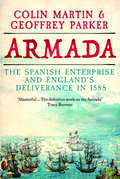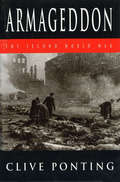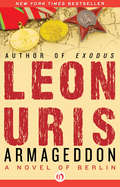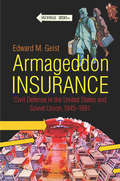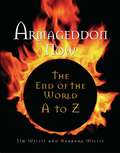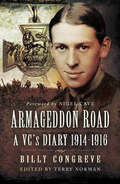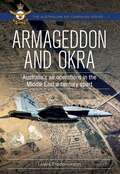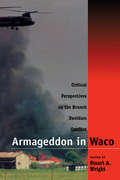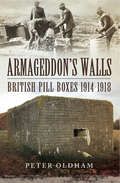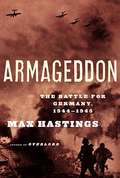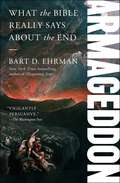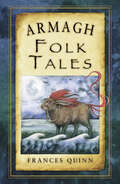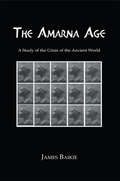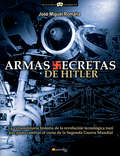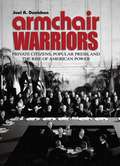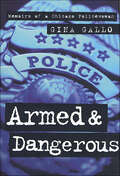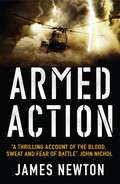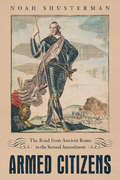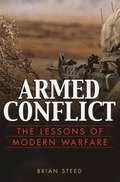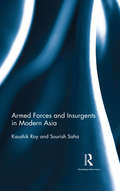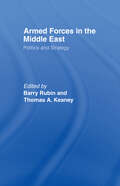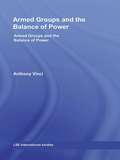- Table View
- List View
Armada: The Spanish Enterprise and England's Deliverance in 1588
by Geoffrey Parker Colin MartinThe definitive history of the Spanish Armada, lavishly illustrated and fully revised“Will surely become the definitive account.”—Stephen Brumwell, Wall Street Journal In July 1588 the Spanish Armada sailed from Corunna to conquer England. Three weeks later an English fireship attack in the Channel—and then a fierce naval battle—foiled the planned invasion. Many myths still surround these events. The genius of Sir Francis Drake is exalted, while Spain’s efforts are belittled. But what really happened during that fateful encounter? Drawing on archives from around the world, Colin Martin and Geoffrey Parker also deploy vital new evidence from Armada shipwrecks off the coasts of Ireland and Scotland. Their gripping, beautifully illustrated account provides a fresh understanding of how the rival fleets came into being; how they looked, sounded, and smelled; and what happened when they finally clashed. Looking beyond the events of 1588 to the complex politics which made war between England and Spain inevitable, and at the political and dynastic aftermath, Armada deconstructs the many legends to reveal why, ultimately, the bold Spanish mission failed.
Armageddon
by Clive PontingFifty years after the end of World War II Clive Ponting provides a major reassessment of the most destructive conflict in human history - one in which 85 million people died.Armageddon avoids conventional chronological accounts in order to concentrate on the deeper forces shaping the origins, course and outcome of the war across the globe. It analyses how and why the war spread from being a limited European conflict to the only global war, why countries were dragged into the fighting and how only a small number of neutral states escaped. It compares the two alliances, how they mobilized their resources and their strategies for victory. It avoids a detailed description of how commanders maneuvered on the battlefield and concentrates instead on the impact the war had on individual soldiers, sailors and airmen. Equally important is the fate of hundreds of millions of civilians. How did they survive occupation and what did resistance, collaboration and liberation really involve, and what happened at the end of the war?Armageddon has a truly global sweep, combined with an eye for detail, and provides fascinating comparisons from a multi-faceted war. It contains new facts, asks provocative questions and challenges many of the common assumptions about the war. It is a compelling new inquiry.
Armageddon
by Leon UrisIn Berlin at the end of World War II, an American Army officer bears witness to the aftermath of one historic tragedy and the rise of another Captain Sean O'Sullivan distinguishes himself as a courageous soldier in the closing days of World War II, but what comes next tests his deepest reserves of strength and conviction. Sent to oversee the rebuilding of Berlin, O'Sullivan is exposed to the horrific truths of the Holocaust, a shattered and defeated society, and the new threat of Soviet power as the Iron Curtain begins to shadow the city. When Soviet forces blockade Berlin and the airlift begins, O'Sullivan is faced with profound moral dilemmas in an increasingly complicated world. Armageddon is one of the great fictional portrayals of Europe in the earliest days of the Cold War. This ebook features an illustrated biography of Leon Uris including rare photos from the author's estate.
Armageddon Insurance: Civil Defense in the United States and Soviet Union, 1945–1991 (The New Cold War History)
by Edward M. GeistThe dangerous, decades-long arms race between the United States and the Soviet Union during the Cold War begged a fundamental question: how did these superpowers actually plan to survive a nuclear strike? In Armageddon Insurance, the first historical account of Soviet civil defense and a pioneering reappraisal of its American counterpart, Edward M. Geist compares how the two superpowers tried, and mostly failed, to reinforce their societies to withstand the ultimate catastrophe.Drawing on previously unexamined documents from archives in America, Russia, and Ukraine, Geist places these civil defense programs in their political and cultural contexts, demonstrating how each country's efforts reflected its cultural preoccupations and blind spots and revealing how American and Soviet civil defense related to profound issues of nuclear strategy and national values. This work challenges prevailing historical assumptions and unearths the ways Moscow and Washington developed nuclear weapons policies based not on rational strategic or technical considerations but in power struggles between different institutions pursuing their own narrow self-interests.
Armageddon Now
by Jim Willis Barbara WillisFire or ice, bang or whimper, asteroid or alien, act of God or human folly--"Armageddon Now" is all about doomsday prophecies. From alpha to omega, the book is packed with 200 entries and 100 illustrations. In the final analysis, the end has never been so thoroughly covered as in this compendium--the last word for the end user.
Armageddon Road: A VC's Diary, 1914–1916
by Billy CongreveBilly Congreve was an exceptional soldier and an exceptional man. By the time he was killed on the Somme in July 1916 at the age of twenty-five he had been awarded the DSO, MC, and the Lgion d'Honneur, and for his many deeds of gallantry on the Somme, a posthumous VC.Born into a military family (his father General Congreve had also won the VC) he became a regular soldier in the Rifle Brigade before the war, and in France became a staff officer, but one who chose to be in the front line as often as he could. This makes his remarkable diaries all the more valuable since he writes from the thick of the fighting and yet retains an objectivity that enables him to observe all that is going on around him both in the trenches and at headquarters.Terry Norman carefully edited the diary to set his story in the context of the war, and thus provide an exceptional picture of what an officer thought of the conduct of the war side by side with his personal grief at the loss of his friends and the wastage of human life.Out of print for over 30 years, this special centenary edition of this classic work includes a new foreword from esteemed military author Nigel Cave, as well as an expanded introduction from Terry's widow, Joan and a newly designed plate section. Detailing the extraordinary exploits of a truly remarkable man during the first two years of the war, this book is a compulsive purchase for all fans of the period.
Armageddon and OKRA: Australia's air operations in the Middle East a century apart (Australian Air Campaign Series #1)
by Lewis FredericksonThe dispatch of an Ottoman Army by Australian-led Imperial air power in the Wadi Fara on 21 September 1918 occurred just five years after the advent of military aviation in Australia. In 1914, the fledgling Australian air service operated the flimsy Bristol Boxkite; four years later it was flying the far more advanced Bristol F2B Fighter. This leap forward represented a profound progress in technology that has typified the technical development of aviation, particularly in Australia ever since. Ironically, on 21 September 2014, 96 years after the events of the Wadi Fara, Australian squadrons were again deployed to the same part of the world where they would remain for more than three years on operations against extremist terrorism. Armageddon and OKRA contrasts these events, a century apart, in the context of the development of Australian air power. The book tracks the history where Australia has maintained a balanced air service compelling high technical, logistics and engineering standards, and effective training and command and control systems, for more than 100 years. These processes were as applicable a century ago as they are today. By examining these operational events, the author establishes the connection that access to the technology associated with air power is intrinsically linked to Australia&’s enduring foreign and defence policy – more so, that military power is a means to an end, and never an end unto itself.
Armageddon in Waco: Critical Perspectives on the Branch Davidian Conflict
by Stuart A. WrightOn February 28, 1993, the United States Bureau of Alcohol, Tobacco, and Firearms (BATF) launched the largest assault in its history against a small religious community in central Texas. One hundred agents armed with automatic and semi automatic weapons invaded the compound, purportedly to execute a single search and arrest warrant. The raid went badly; four agents were killed, and by the end of the day the settlement was surrounded by armored tanks and combat helicopters. After a fifty-one day standoff, the United States Justice Department approved a plan to use CS gas against those barricaded inside. Whether by accident or plan, tanks carrying the CS gas caused the compound to explode in fire, killing all seventy-four men, women, and children inside. Could the tragedy have been prevented? Was it necesary for the BATF agents to do what they did? What could have been done differently? Armageddon in Waco offers the most detailed, wide-ranging analysis of events surrounding Waco. Leading scholars in sociology, history, law, and religion explore all facets of the confrontation in an attempt to understand one of the most confusing government actions in American history. The book begins with the history of the Branch Davidians and the story of its leader, David Koresh. Chapters show how the Davidians came to trouble authorities, why the group was labeled a "cult," and how authorities used unsubstantiated allegations of child abuse to strengthen their case against the sect. The media's role is examined next in essays that considering the effect on coverage of lack of time and resources, the orchestration of public relations by government officials, the restricted access to the site or to countervailing evidence, and the ideologies of the journalists themselves. Several contributors then explore the relation of violence to religion, comparing Waco to Jonestown. Finally, the role played by "experts" and "consultants" in defining such conflicts is explored by two contributors who had active roles as scholarly experts during and after the siege The legal and consitutional implications of the government's actions are also analyzed in balanced, clearly written detail.
Armageddon in Waco: Critical Perspectives on the Branch Davidian Conflict
by Stuart A. WrightOn February 28, 1993, the United States Bureau of Alcohol, Tobacco, and Firearms (BATF) launched the largest assault in its history against a small religious community in central Texas. One hundred agents armed with automatic and semi automatic weapons invaded the compound, purportedly to execute a single search and arrest warrant. The raid went badly; four agents were killed, and by the end of the day the settlement was surrounded by armored tanks and combat helicopters. After a fifty-one day standoff, the United States Justice Department approved a plan to use CS gas against those barricaded inside. Whether by accident or plan, tanks carrying the CS gas caused the compound to explode in fire, killing all seventy-four men, women, and children inside. Could the tragedy have been prevented? Was it necesary for the BATF agents to do what they did? What could have been done differently? Armageddon in Waco offers the most detailed, wide-ranging analysis of events surrounding Waco. Leading scholars in sociology, history, law, and religion explore all facets of the confrontation in an attempt to understand one of the most confusing government actions in American history. The book begins with the history of the Branch Davidians and the story of its leader, David Koresh. Chapters show how the Davidians came to trouble authorities, why the group was labeled a "cult," and how authorities used unsubstantiated allegations of child abuse to strengthen their case against the sect. The media's role is examined next in essays that considering the effect on coverage of lack of time and resources, the orchestration of public relations by government officials, the restricted access to the site or to countervailing evidence, and the ideologies of the journalists themselves. Several contributors then explore the relation of violence to religion, comparing Waco to Jonestown. Finally, the role played by "experts" and "consultants" in defining such conflicts is explored by two contributors who had active roles as scholarly experts during and after the siege The legal and consitutional implications of the government's actions are also analyzed in balanced, clearly written detail.
Armageddon's Walls: British Pill Boxes, 1914–1918
by Peter OldhamThe British Army and her commonwealth Allies went to war in 1914 with little knowledge and experience of constructing permanent, shell proof protective structures. Some masonry fortifications, such as defensive blockhouses in South Africa, had been built but the Royal Engineers of the Army were more versed in simple temporary defences suitable for mobile warfare. Home defences were a limited number of forts around naval ports, and Martello Towers on the east coast. It was considered that the Navy was quite able to defend Britain's coasts.The Germans, on the other hand, as with the other continental countries such as France, Belgium, Italy, Holland, Poland, Austria, etc. had been constantly renewing and updating border forts for several centuries. They had also maintained fortification and siege elements of their armies, who were experienced in designing and constructing strong shelters. Both German and French armies began the war with a degree of expertise in what was to become a static war with little movement. However, by 1918 the British were to surpass both enemy and her allies in the design and construction, with supply and logistics, of such shell proof cover for troops and defensive positions.This book gives the history of development and innovation of concrete bunkers, pill boxes, blockhouses and general concrete constructions during the First World War. Many of these structures some showing obvious signs of war damage - still exist in France and Belgium today.All the existing structures, with photograph (except for some which are impractical, because of dense vegetation,) are shown within. Many entries have contemporary maps showing how they fitted into a defensive system, whilst for others the location can be identified from the text. GPS coordinates are given for each entry, except for a few which are on private land and where privacy has been requested.
Armageddon: The Battle for Germany, 1944-45
by Max HastingsIn September 1944, the Allies believed that Hitler's army was beaten and expected the bloodshed to end by Christmas. Yet a series of mistakes and setbacks, including the Battle of the Bulge, drastically altered this timetable and led to eight more months of brutal fighting. With Armageddon, the eminent military historian Max Hastings gives us memorable accounts of the great battles and captures their human impact on soldiers and civilians. He tells the story of both the Eastern and Western Fronts, raising provocative questions and offering vivid portraits of the great leaders. This rousing and revelatory chronicle brings to life the crucial final months of the twentieth century's greatest global conflict.From the Trade Paperback edition.
Armageddon: What the Bible Really Says about the End
by Bart D. EhrmanA &“humane, thoughtful, and intelligent&” (The New York Times Book Review) bestselling Biblical scholar reveals why our popular understanding of the Apocalypse is all wrong—and why that matters.You&’ll find nearly everything the Bible says about the end in the Book of Revelation: a mystifying prophecy filled with bizarre symbolism, violent imagery, mangled syntax, confounding contradictions, and very firm ideas about the horrors that await us all. But no matter what you think Revelation reveals—whether you read it as a literal description of what will soon come to pass, interpret it as a metaphorical expression of hope for those suffering now, or only recognize its highlights from pop culture—you&’re almost certainly wrong. In Armageddon, acclaimed New Testament authority Bart D. Ehrman delves into the most misunderstood—and possibly most dangerous—book of the Bible, on a &“vigilantly persuasive&” (The Washington Post) tour through three millennia of Judeo-Christian thinking about how our world will end. With wit and verve, he explores the alarming social and political consequences of expecting an imminent apocalypse, considers whether the message of Revelation may be at odds with the teachings of Jesus, and offers inspiring insight into how to live in the face of an uncertain future. By turns hilarious, moving, troubling, and provocative, Armageddon is nothing short of revelatory in its account of what the Bible really says about the end.
Armagh Folk Tales
by Frances QuinnCounty Armagh, the Orchard County, abounds in folk tales, myths and legends and a selection of the best, drawn from historical sources and newly recorded local reminiscence, have been brought to life here by local storyteller Frances Quinn. Armagh is the place where, legend has it, the warrior king Conor Mac Nessa once ruled and where Deirdre of the Sorrows met her lover Naoise. It is where St Mochua’s Well was said to curse, not cure and where evidence of St Patrick’s disagreement with a bull can still be seen. And it is where Mrs Lester lived to a ripe old age – many years after her burial. It is also said to be the home of a plethora of strange and magical creatures and stories abound of encounters with fairies, dragons, ghosts, witches and even a giant pig. From age-old legends and fantastical myths to amusing anecdotes and cautionary tales, this collection is a heady mix of bloodthirsty, funny, passionate and moving stories. It will take you into a remarkable world where you can let your imagination run wild.
Armana Age: A Study Of The Crisis Of The Ancient World
by James BaikieWhen we consider the Cretans and Hittites, the powers of Babylonia and Assyria, and the internal conditions in Syria and Palestine, it can hardly be doubted that the reign of Akhetaten marks a turning point, notably in Egyptian history, but also in the wider history of the ancient world. Here the author vigorously reproduces this age, to show the intensely human interest that lies in the story of religion and art of decadence and reform.
Armance
by Morgane PinonFlorian acaba de heredar una fortuna de su tía Marie. Dejándose llevar por un impulso, decide dejar todo atrás, huyendo de su vida en París, para trasladarse a un palacete de la época victoriana. Su intención es restaurar el edificio para devolverle el esplendor de antaño y recibir en él turistas que quieran vivir un auténtico viaje en el tiempo. Unos meses más tarde, los trabajos avanzan a buen ritmo hasta que el Estado impone un confinamiento para evitar la propagación de un virus por el país. Florian se ve solo en ese gran edificio, incapaz de terminar las obras por su cuenta. Por casualidad, consigue acceder a una sala secreta escondida detrás de un espejo, en la que encuentra objetos que llevan más de ciento cincuenta años sin ver la luz. Entre ellos, encuentra el diario personal de Armance de Bellieu. Para mantenerse ocupado, Florian se lanza a descubrir qué clase de secretos ocultaba aquella joven mujer del pasado… «Una novela romántica contemporánea e histórica que te hará descubrir los alrededores de la costa armoricana…» «Un viaje a la vez lingüístico y culinario»
Armance
by Morgane PinonFlorian ha appena ereditato la fortuna di sua zia Maria. All’improvviso, decide di abbandonare tutto per fuggire dalla vita parigina, a favore di un maniero dell’epoca vittoriana. Vuole restaurare la casa per riportarla al suo antico splendore e offrire ai suoi clienti delle camere per gli ospiti, garantendo un viaggio di successo attraverso il tempo. Dopo qualche mese, i lavori procedono bene fino al giorno in cui lo Stato impone un confinamento per limitare la diffusione del virus nel Paese. Florian si ritrova ormai solo in questo grande edificio e impossibilitato a finire i lavori in corso con i propri mezzi. Per caso, entra in una stanza segreta nascosta dietro uno specchio. Il giovane ci trova diversi oggetti, che non vedono la luce da più di 150 anni. Tra queste antichità c’è un diario scritto da Armance de Bellieu. Per occupare il suo tempo, Florian si diverte a scoprire i segreti che questa giovane donna del passato potrebbe nascondere... «Una storia d’amore contemporanea e torica che vi farà scoprire i dintorni della costa armoricana…» «Un viaggio linguistico e culinario allo stesso tempo.»
Armas secretas de Hitler (Historia Incógnita)
by Miguel José RomañaDurante los dos últimos años de la Segunda Guerra Mundial, los avances tecnológicos logrados por Alemania fueron sorprendentes. Junto a aviones a reacción de los más variados y vanguardistas diseños, llegaron las aeronaves discoidales de prestaciones nunca imaginadas. A ello se unieron “armas maravillosas” como misiles para cualquier acción bélica, increíbles “bolas de fuego”, submarinos indetectables, cañones sónicos y eléctricos, la bomba endotérmica, y un largo etcétera de armamento prodigioso.
Armchair Warriors
by Joel R. DavidsonThis book is a history of public information and personal ideas about war and the military over the last century. It examines the interplay between popular media coverage of the nation's wars and the perceptions of ordinary Americans regarding military issues. Davidson studied Americans who produced a wealth of proposals to solve some of the most pressing military problems of their day. His book consists of hundreds of letters sent to those in charge of the armed forces, advising them on issues ranging from grand strategy to individual combat. Davidson sets their letters alongside extracts from the contemporary popular press to illustrate the ways that the media both informed and motivated the public to think about war. This is the first book to look at the ideas of ordinary citizens regarding military matters.
Armed & Dangerous: Memoirs of a Chicago Policewoman
by Gina GalloThe critically acclaimed memoirs of one female police officer's sixteen-year odyssey, beginning with day one at the Police Academy and spanning assignments on Chicago's West Side, one of the most dangerous areas in the city.The notorious cops' code of silence is broken as the author recounts incidents in the West Side projects: shoot-outs, ambushes, and what it feels like to kill a man—just four days out of the Academy.The stories told are sometimes tragic, sometimes funny, often poignant, and always provide the reader with an on the scene feel for life behind the badge. Domestic violence, murdered spouses, abused children, and philandering CPD brass are just some of the topics addressed, topics that officer Gallo dealt with everyday.From her work with gangs, narcotics, the gun task force, and acting as a prostitute, Gina Gallo offers a gritty account of the darker side of the city, giving readers an objective side to the cops, crooks, and victims that comprise a the police cops world.At the Publisher's request, this title is being sold without Digital Rights Management Software (DRM) applied.
Armed Action
by James Newton, Dfc'I couldn't see the tank. I couldn't see it... Someone was screaming over the radio. "Scream all you want, I still can't see it," I said to my pilot. The next explosion was so close it lifted my chest armour off my body in the shock wave. The noise brought me back to my awful reality. I looked out of the sight to see the shattered cockpit glass. The next one would be it and we knew it.' Lieutenant Commander James Newton survived and was awarded the Distinguished Flying Cross for his bravery. In a career that has seen him on operations over Bosnia, Sierra Leone, Northern Ireland and most recently Iraq, Newton is no stranger to being shot at. He has flown all the aircraft the Navy has and even ones it doesn't. Thrilling, fast-paced and an adrenaline-fuelled adventure, Armed Action is a fascinating insight into life in the air.
Armed Citizens: The Road from Ancient Rome to the Second Amendment
by Noah ShustermanAlthough much has changed in the United States since the eighteenth century, our framework for gun laws still largely relies on the Second Amendment and the patterns that emerged in the colonial era. America has long been a heavily armed, and racially divided, society, yet few citizens understand either why militias appealed to the founding fathers or the role that militias played in North American rebellions, in which they often functioned as repressive—and racist—domestic forces. In Armed Citizens, Noah Shusterman explains for a general reader what eighteenth-century militias were and why the authors of the Constitution believed them to be necessary to the security of a free state. Suggesting that the question was never whether there was a right to bear arms, but rather, who had the right to bear arms, Shusterman begins with the lessons that the founding generation took from the history of Ancient Rome and Machiavelli’s reinterpretation of those myths during the Renaissance. He then turns to the rise of France’s professional army during seventeenth-century Europe and the fear that it inspired in England. Shusterman shows how this fear led British writers to begin praising citizens’ militias, at the same time that colonial America had come to rely on those militias as a means of defense and as a system to police enslaved peoples. Thus the start of the Revolution allowed Americans to portray their struggle as a war of citizens against professional soldiers, leading the authors of the Constitution to place their trust in citizen soldiers and a "well-regulated militia," an idea that persists to this day.
Armed Conflict: The Lessons of Modern Warfare
by Brian SteedWhat challenges will America face in armed conflicts of the future and how will we prepare for them? National security depends upon the ability of the military to predicto the future nature of war. Despite the difficulty in making such predictions, one must remember: nation states and other countries will continue to use armed conflict as a means to further their aims, and these aims will, at times, run contrary to American interests. As a result, the United States will continue to be confronted with armed conflict in the days and years ahead. A military theorist and experienced armor officer, Brian Steed provides insights into the future of armed conflict by focusing on what has occurred in the pastunot because the past repeats itself, but because it reveals timeless principles of warfare. Five battles, one each in Korea, Vietnam, the Falklands, the Persian Gulf, and Somalia are analyzed historically, geographically, and strategically. Steed's analysis of these engagements clearly demonstrates that the key to victory on the battlefields of the future is the small unit. In refreshing layman's prose, the author focuses on why the events occurred as they did, and explores the significance of each battle in terms of its political and military ramifications. He concludes with lessons learned that will greatly benefit future American ground combat commanders. Armed Conflict informs the reader about the historical trends of combat operations and the realities of warutoday and into the future. It will also serve to guide a new generation of military and civilian leaders as they prepare to face the inevitable conflicts in the new century.
Armed Forces and Insurgents in Modern Asia
by Kaushik Roy Sourish SahaThis volume traces the historical roots and evolution of insurgencies and counter-insurgencies in modern Asia. Focusing on armed rebellions and use of armed forces by both Western powers and indigenous states from the nineteenth century till present day, the volume unravels the problematic of change–continuity and addresses key questions on the nature of warfare. The book looks at eight different regions of Asia: US counter-insurgencies in Philippines; the British initiative in Indonesia and independent Indonesia’s counter-insurgency against its domestic populace; post-World War II Malaya; French and US war in Vietnam; British and Indian counter-insurgencies in North-East India between the nineteenth and early twenty-first century; Indian and Sri Lankan operations in Sri Lanka during late twentieth and early twenty-first centuries; British and US-NATO war in Afghanistan from the nineteenth century till 2014; and British and US counter-insurgency in Iraq during the twentieth and first two decades of the twenty-first centuries. The volume will greatly interest scholars and researchers of modern Asian history, military and strategic studies, politics and international relations as well as government institutions and think-tanks.
Armed Forces in the Middle East: Politics and Strategy (Besa Studies In International Security)
by Barry Rubin Thomas A. KeaneyAn examination of the Middle East's leading armed forces and their role in both military and political affairs. The book considers their missions, doctrine, training, equipment and effectiveness as fighting forces.
Armed Groups and the Balance of Power: The International Relations of Terrorists, Warlords and Insurgents (LSE International Studies Series)
by Anthony VinciThis new book provides a framework for understanding the international relations of armed groups, including terrorist organizations, insurgencies and warlords, which play an increasingly important role in the international system. Specifically, the book argues that such groups can be understood as taking part in the balance of power with states and other armed groups, as they are empirically sovereign non-state actors that are motivated by the pursuit of power and exist as part of an anarchic, self-help system. This radically new approach offers a renewed conceptualization of Neorealism, and provides new insights into debates about sovereignty, non-state actors, new wars, counterterrorism, and counterinsurgency. The approach is illustrated through case studies on Somali warlords, the security complex between the Lord’s Resistance Army (LRA), Sudanese People’s Liberation Army (SPLA), Sudan and Uganda, as well as Al Qaeda. The book provides insights into such issues as how non-state actors can be integrated into structural theories of international relations, and also offers pragmatic methodologies for the foreign policy or military practitioner, such as how to best deter terrorists.
